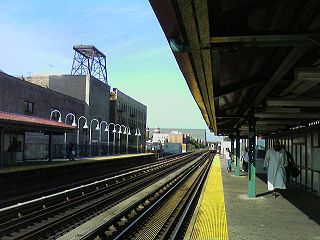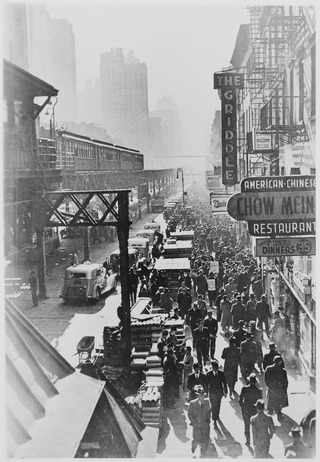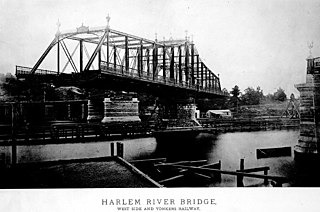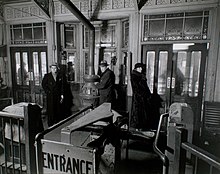
The Dual Contracts, also known as the Dual Subway System, were contracts for the construction and/or rehabilitation and operation of rapid transit lines in the City of New York. The contracts were signed on March 19, 1913, by the Interborough Rapid Transit Company and the Brooklyn Rapid Transit Company. As part of the Dual Contracts, the IRT and BRT would build or upgrade several subway lines in New York City, then operate them for 49 years.

The Interborough Rapid Transit Company (IRT) was the private operator of New York City's original underground subway line that opened in 1904, as well as earlier elevated railways and additional rapid transit lines in New York City. The IRT was purchased by the city in June 1940, along with the younger BMT and IND systems, to form the modern New York City Subway. The former IRT lines are now the A Division or IRT Division of the Subway.

The Bedford Park Boulevard–Lehman College station is a local station on the IRT Jerome Avenue Line of the New York City Subway. Located at the intersection of Bedford Park Boulevard immediately west of Jerome Avenue in the Bronx, it is served by the 4 train at all times. It is also the only station on the Jerome Avenue Line north of 170th Street that is not located above Jerome Avenue. This station was constructed by the Interborough Rapid Transit Company as part of the Dual Contracts and opened in 1918.

The Kingsbridge Road station is a local station on the elevated IRT Jerome Avenue Line of the New York City Subway. Located at the intersection of Kingsbridge Road and Jerome Avenue in Kingsbridge Heights, Bronx, it is served by the 4 train at all times. This station was constructed by the Interborough Rapid Transit Company as part of the Dual Contracts and opened in 1917.

The Fordham Road station is a local station on the IRT Jerome Avenue Line of the New York City Subway. Located at the intersection of Fordham Road and Jerome Avenue in the Bronx, it is served by the 4 train at all times. This station was constructed by the Interborough Rapid Transit Company as part of the Dual Contracts and opened in 1917.

The 183rd Street station is a local station on the elevated IRT Jerome Avenue Line of the New York City Subway. Located at the intersection of 183rd Street and Jerome Avenue in the Bronx, it is served by the 4 train at all times. This station was constructed by the Interborough Rapid Transit Company as part of the Dual Contracts and opened in 1917.

The Burnside Avenue station is an express station on the IRT Jerome Avenue Line of the New York City Subway. Located at the intersection of Burnside and Jerome Avenues in the Bronx, it is served by the 4 train at all times. It also serves as a rush hour short turn northern terminal for select 4 trains from Crown Heights–Utica Avenue.

The 176th Street station is a local station on the IRT Jerome Avenue Line of the New York City Subway. Located at the intersection of 176th Street and Jerome Avenue in the Bronx, it is served by the 4 train at all times. This station was constructed by the Interborough Rapid Transit Company as part of the Dual Contracts and opened in 1917.

The Mount Eden Avenue station is a local station on the IRT Jerome Avenue Line of the New York City Subway. Located at the intersection of Mount Eden and Jerome Avenues in the Bronx, it is served by the 4 train at all times. This station was constructed by the Interborough Rapid Transit Company as part of the Dual Contracts and opened in 1917.

The 167th Street station is a local station on the IRT Jerome Avenue Line of the New York City Subway. Located at the intersection of 167th Street and River Avenue in the Bronx, it is served by the 4 train at all times. This station was constructed by the Interborough Rapid Transit Company as part of the Dual Contracts and opened in 1917.
The IRT Lexington Avenue Line is one of the lines of the A Division of the New York City Subway, stretching from Lower Manhattan north to 125th Street in East Harlem. The line is served by the 4, 5, 6, and <6> trains.

The IRT Third Avenue Line, commonly known as the Third Avenue Elevated, Third Avenue El, or Bronx El, was an elevated railway in Manhattan and the Bronx, New York City. Originally operated by the New York Elevated Railway, an independent railway company, it was acquired by the Interborough Rapid Transit Company (IRT) and eventually became part of the New York City Subway system.
The IRT Jerome Avenue Line, also unofficially known as IRT Woodlawn Line, is an A Division New York City Subway line mostly along Jerome Avenue in the Bronx. Originally an Interborough Rapid Transit Company-operated route, it was built as part of the Dual Contracts expansion and opened in 1917 and 1918. It is both elevated and underground, with 161st Street–Yankee Stadium being the southernmost elevated station. The line has three tracks from south of the Woodlawn station to the 138th Street–Grand Concourse station. The Woodlawn Line also has a connection to the Jerome Yard, where 4 trains are stored, just north of the Bedford Park Boulevard–Lehman College station.

The IRT Sixth Avenue Line, often called the Sixth Avenue Elevated or Sixth Avenue El, was the second elevated railway in Manhattan in New York City, following the Ninth Avenue Elevated.
The 155th Street station was an elevated railway station in Manhattan, New York City, that operated from 1870 until 1958. It served as the north terminal of the IRT Ninth Avenue Line from its opening until 1918 and then as the southern terminal of a surviving stub portion from 1940 until its closure in 1958. It had two tracks and one island platform.

The 161st Street–Yankee Stadium station is a New York City Subway station complex shared by the elevated IRT Jerome Avenue Line and the underground IND Concourse Line. It is located at the intersection of 161st Street and River Avenue in the Highbridge and Concourse neighborhoods of the Bronx. It is generally served by the 4 train at all times; the D train at all times except rush hours in the peak direction ; and the B train during rush hours.

The Sedgwick Avenue station was an elevated, ground level and underground station on the Bronx extension of the IRT Ninth Avenue Line in Highbridge, Bronx, New York City.

The Putnam Bridge was a swing bridge that spanned the Harlem River and the adjacent tracks of the New York Central Railroad in New York City. The bridge connected Harlem in Manhattan to Concourse, near the current location of Yankee Stadium, in the Bronx. It carried two tracks of the New York and Putnam Railroad, and later the 9th Avenue elevated line of the Interborough Rapid Transit Company (IRT), as well as two pedestrian walkways outside the superstructure.

















